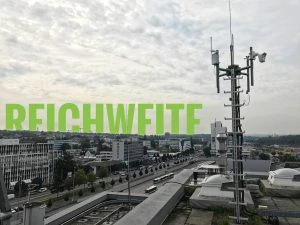We'll show you how your company can use IoT to improve asset tracking in the supply chain and what the benefits are.
Asset tracking in the supply chain
In this article, you will learn how the integration of IoT-enabled asset tracking into the supply chain can help to uncover undiscovered potential and thus bring about a significant increase in return on investment (ROI). We will also look specifically at how these advanced tracking solutions can increase your operational efficiency and competitiveness.

Introduction: IoT in the supply chain
In the modern economy, the efficient management of supply chains is a key success factor for companies. A key element of this is asset tracking, which involves the seamless tracking of assets across the entire supply chain. These assets range from physical goods such as raw materials, components and finished products to documents.
Progress in the field of asset tracking is also continuously advancing through innovative technologies and it is essential to recognize this early on. The advent of the Internet of Things (IoT) has ushered in a revolution in the way assets are tracked and managed. IoT devices enable precise and seamless real-time tracking. The ability to know the exact location and condition of any asset at any point in time holds enormous potential. It enables increased efficiency, cost savings and increased supply chain visibility.
In the next section, we will take a closer look at the use of IoT in the supply chain, highlighting all the benefits and challenges of this technology.
Building an intelligent supply chain with IoT
First, we take a look at the opportunities that can arise by unlocking hidden potential using IoT. We then look at both direct and indirect savings that can be realized through a smart supply chain with IoT.
Unlocking hidden potential in the supply chain
Hidden potential in the supply chain can mainly be tapped by identifying underutilized assets, optimizing life cycles and better allocation of assets. We will now look at these opportunities in more detail below.
Identification of underutilized assets through tracking
By using IoT, companies can obtain a precise picture of how their assets are used over time. This includes aspects such as operating times, downtimes, frequency and usage and maintenance intervals. The data can be used to identify patterns of underutilization. For example, the system can determine whether certain machines or vehicles are effectively utilized to their maximum capacity or whether they remain unused at certain times.
In addition, improved capacity utilization can help to reduce the ecological footprint. The need for new purchases is minimized and existing resources are continuously used optimally. Overall, this contributes to a more efficient use of resources, reduces unnecessary costs and ultimately increases the overall performance of the supply chain.

Optimization of life cycles and maintenance schedules through IoT devices in the supply chain
IoT devices in the supply chain continuously collect data on the operating status and performance of assets. This data enables the identification of patterns and trends that indicate upcoming maintenance work. By using predictive maintenance strategies, a company can use IoT applications to reduce downtime and extend the life of its assets.
IoT technology allows assets to be monitored and controlled remotely. This means that problems can be resolved quickly even without the physical presence of technicians, which significantly increases responsiveness. Regular maintenance and monitoring by IoT devices not only contributes to efficiency, but also to improved safety, as potential hazards can be detected at an early stage.
Improving asset allocation on the basis of usage data
By analyzing usage data, companies can develop a better understanding of how demand changes over time. Based on these insights, they can update their allocation of assets accordingly to ensure an optimal match between supply and demand. Storage costs can be reduced as only as much stock is held as is actually needed.
By allocating assets more efficiently, costs can be reduced as fewer resources are wasted. It also increases operational efficiency by ensuring that each asset is deployed where it is most needed.
Increasing ROI through strategic asset tracking
Increasing the return on investment (ROI) through strategic tracking is an important aspect. This can be achieved through both direct cost savings and indirect optimization of ROI. The specific savings must be examined individually; some common examples are explained below.
Direct cost savings through efficient asset tracking
- Reduction of warehousing costs: Efficient tracking enables the optimization of stock levels, which leads to a reduction in warehousing costs and capital commitment.
- Improved maintenance efficiency : Precise asset tracking allows maintenance work to be planned in a more targeted and efficient manner, resulting in savings on maintenance costs.
- Less redundancy: Efficient use of assets reduces the need to buy or rent additional or redundant equipment.
- Reduction of losses and theft: Precise tracking of assets enables companies to minimize losses and theft.
Indirect ROI increases through better data and analyses
- Increasing productivity: Detailed insights into the use and performance of assets can lead to process improvements and thus increase productivity.
- Planning and trend analysis: In the long term, asset tracking enables the collection of valuable data for trend analysis and future planning, which contributes to continuous improvement and adaptation to market changes.
- Quality improvement: Faster detection of quality problems leads to faster rectification, which improves product quality and at the same time increases customer satisfaction.
- Facilitated decision-making: The detailed data collected through IoT supports informed decision making, reduces wrong decisions regarding new purchases and asset decommissioning.

Summary: The supply chain and IoT
Let's summarize the topic of supply chain and IoT. The integration of IoT reveals previously hidden potential such as improved capacity utilization, optimized life cycles and an ideal allocation of assets. These changes have both a direct and indirect impact on the cost structure.
It is therefore crucial for companies to evaluate their current tracking processes and consider how these can be optimized through the implementation of advanced technologies. This could mean updating existing systems or introducing customized solutions that better meet the specific needs of your business. These measures will increase efficiency and profitability in the supply chain. This strategic decision will sustainably increase competitiveness and return on investment in the long term.
If you, as a decision-maker in a company, have previously pursued other approaches to asset tracking, now is the ideal time to consider a new direction. It is best to lay the foundations for this today.





